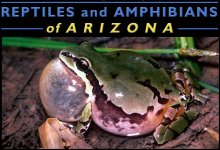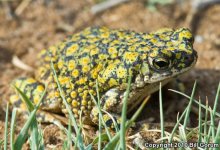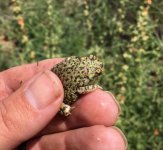| Range: |
 |
| Other Names: |
|
| Subspecies: |
Western Green Toad Anaxyrus debilis insidior |
| Description: |
The Green toad is a small (to 2 inches in length), flattish toad with a dorsal color of green or yellow-green with small black spots and bars that do not connect to form reticulations (see the description for the similar Sonoran green toad). The ventral surface is white or cream. This species has large, elongated parotoid glands; numerous warts on the back, head, and limbs; and horizontal pupils. The cranial crests are weak or absent. Males have a dark or dusky throat, whereas females have a yellow or white throat. The tadpoles grow to about one inch prior to metamorphosis. Small tadpoles (<0.3 inch) are black, but obtain a mottled pattern as they develop. The ventral surface is light colored and the tail fin is highly arched. |
| Similar Species: |
Couch's Spadefoot has smooth skin and no warts. |
| Habitat: |
This secretive, burrowing species inhabits valleys and bajadas characterized by semi-desert grasslands and Chihuahuan Desertscrub. Green toads are typically found at rain pools, cattle tanks, and other sites that fill with water during the summer monsoon. |
| Behavior: |
Primarily nocturnal, this species typically passes the day under surface cover, in rodent burrows, or other subterranean retreats. Some males may be heard calling by day at the peak of the summer breeding season. |
| Hibernation: |
Underground during the cool months. |
| Reproduction: |
Breeding commences with the first significant, summer monsoon storm and typically lasts only 1-3 days. Breeding in Arizona occurs in ephemeral waters filled by summer rains. Males call from the shoreline or in very shallow water; their call is a nasal, insect-like high-pitched buzz that lasts 2-10 seconds. The call is similar to the Sonoran green toad and Great Plains narrow-mouthed toad. Eggs of this species have not been well described, but one clutch consisted of 1,287 eggs laid singly. Another author reported eggs laid in small strings and attached to vegetation. Eggs probably hatch in 1-2 days and, based on limited information, metamorphosis likely occurs in 2-4 weeks. In southwestern New Mexico, metamorphosing Green toads have been found as late as 27 September, but most metamorphose in late July. |
| Diet: |
Green toads feed on a variety of small invertebrates, such as ants, small butterflies and moths, beetles, and small grasshoppers.
|
Adapted from account at reptilesofaz.org
Sources:


|













